Uka (Los Angeles, CA)
Uka at Japan House at Ovation Hollywood
6801 Hollywood Blvd, Los Angeles, CA 90028
213-808-2021
www.japanhousela.com/restaurant/uka/
Sun 07/14/2024, 05:00p-07:40p
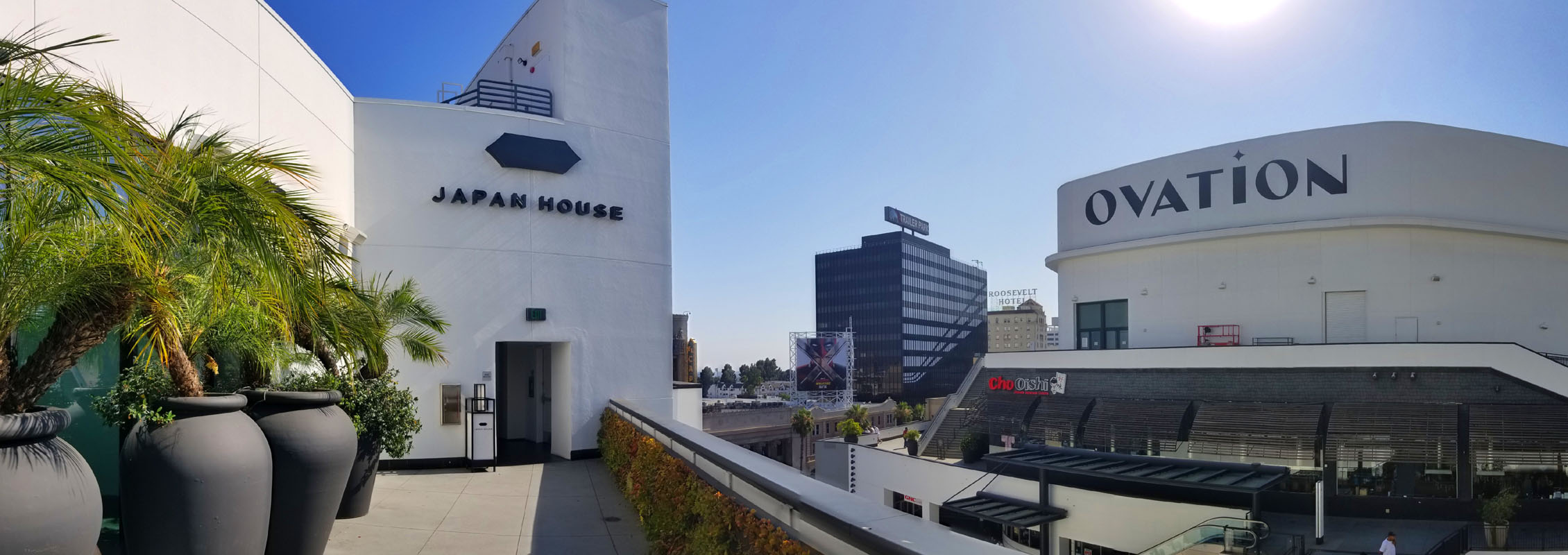
Back in 2019, I enjoyed a lovely meal at Inn Ann, a sushi spot located inside Japan House, a venue funded by the Japanese government that's meant to promote the country's culture. However, Inn Ann closed at the start of 2020, with the idea that the restaurant would be transformed into a "culinary incubator" of sorts. The pandemic delayed those plans, and the place only re-opened in February 2022 with a dinner series entitled "A5 Wagyu Experience," which ran through that April. It was followed by "Ramen Discoveries" (May to July 2022), "Defining Modern Kaiseki" with Hiroo Nagahara (November to December 2022), and finally, "SAIDO's Vegan Way" with Katsumi Kusumoto (January 2023). Not long after, it was announced that the space would become Uka (宇迦), a kaiseki-focused concept named after Ukanomitama-no-kami (宇迦之御魂神), a deity associated with food. The newcomer grand-opened at the start of June last year, helmed by Yoshitaka Mitsue and Shingo Kato.
About the Chefs: Mitsue Yoshitaka (満江善隆) was born and raised in the city of Imari in Saga Prefecture. He attended Saga Prefectural Imari Agricultural and Forestry High School (佐賀県立伊万里農林高等学校), graduating in 1989, and at the age of 18, started his culinary apprenticeship in Osaka. During this period, he largely focused his attention on kappo-style cookery, and also worked at a fish market for two years. By 1999, he was abroad for the first time cooking at Restaurant Suntory in Paris, which was located on Rue Lincoln just off the Champs-Élysées, in the current home of Le Bar Ladurée. In April 2007, Mitsue opened his own eight-seater kappo spot in Kobe: 旬彩和食 朱zaku, or Junsai Washoku Suzaku.
This was followed up in 2011 by See Daeng (スィーデーン), a Thai eatery located nearby. However, he shuttered Suzaku in September 2014, and the following month, moved with his wife Aya to New York to become Chef for the Permanent Mission of Japan to the United Nations. He stayed in that position until November 2019, after which he returned to Japan for a bit, then relocated to Strasbourg, France in 2020. There, he headed up the kitchen at the official residence of the Consul General of Japan before returning back to the US and joining the team at Japan House.
Sous Chef Kato Shingo (加藤眞吾) was born in Zushi, Kanagawa in 1988. He attended culinary school at the Tokyo Seishin Technical College for Cooking (東京誠心調理師専門学校), where he largely trained in Western cookery. Following his studies, he taught for six months, then landed a position at Tokyo's iconic Imperial Hotel, where he specialized in French cuisine. In 2013, Kato came to the US to cook at the Permanent Mission of Japan to the United Nations, where he again focused on French, though he also developed more of an appreciation for Japanese cooking during his tenure there. Following, he returned to the Imperial Hotel in 2016, but in 2019, left for Riga, Latvia to cook at the Embassy of Japan. Two years later, the Chef was back at the Imperial Hotel's casual Parkside Diner, where he stayed until coming to LA, officially starting work at Uka in May 2023.
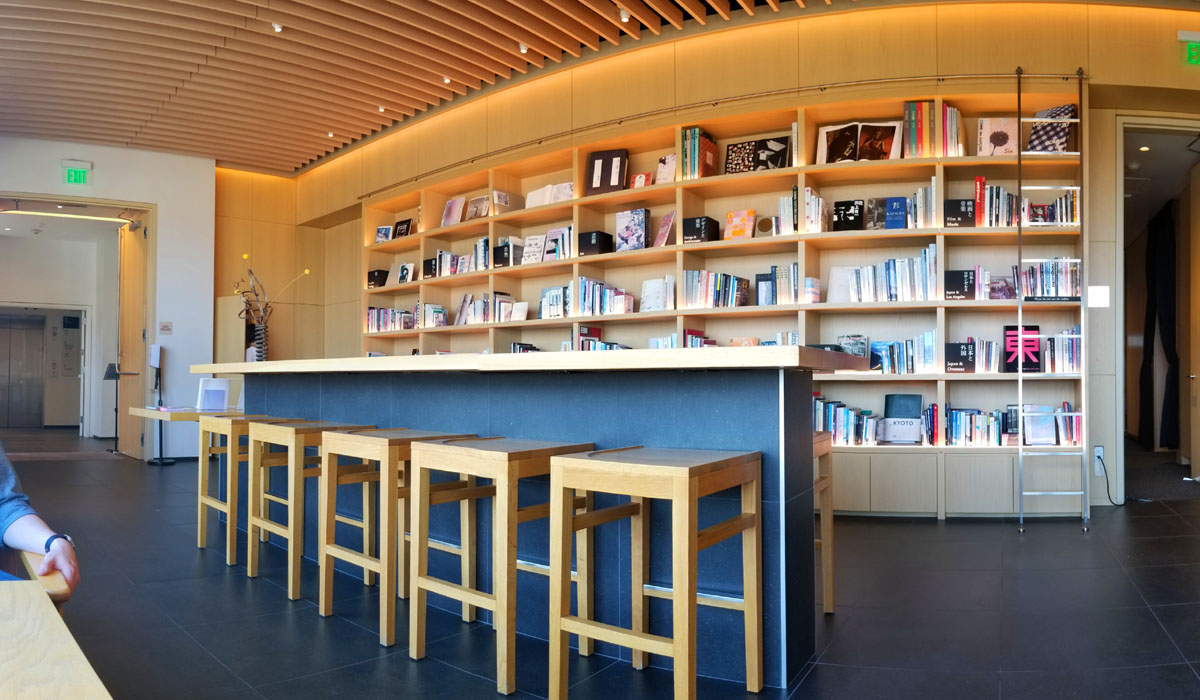
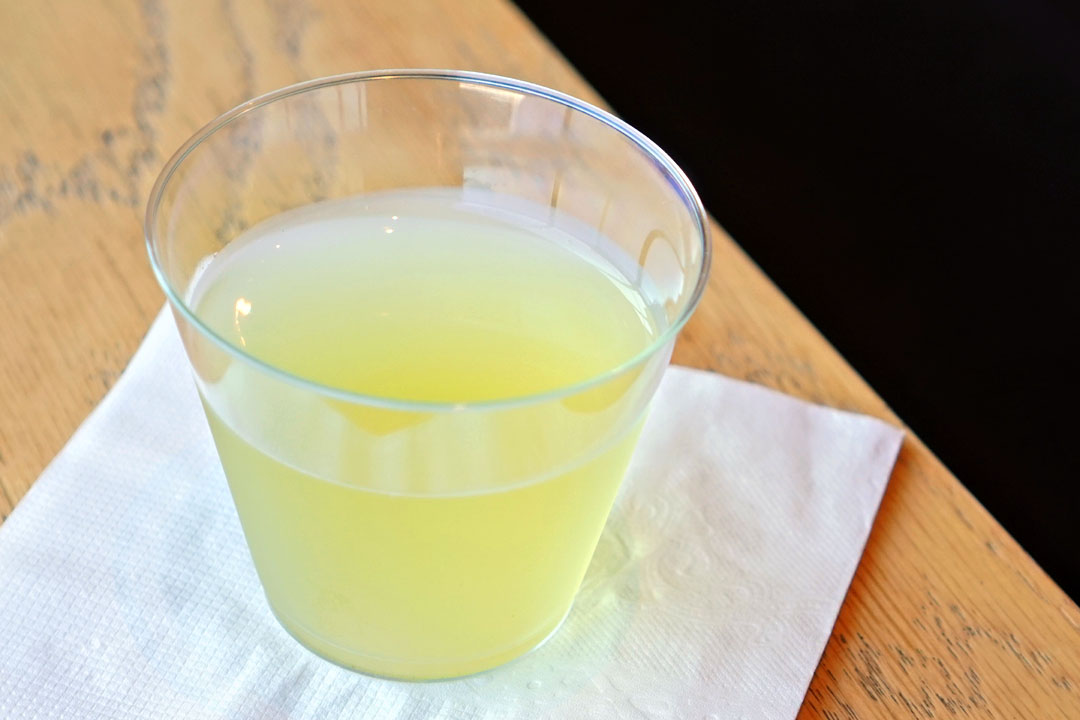
We arrived early for our reservation, and thus waited for a bit in the library, where we enjoyed some complimentary iced green tea.

Inside the Ryu Kosaka-designed restaurant, things haven't changed much at all from the Inn Ann days. Shown above is my view from the leftmost section of the dining counter.
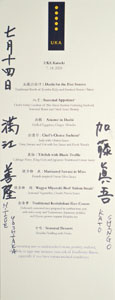

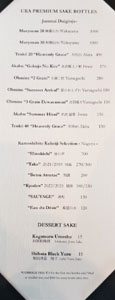
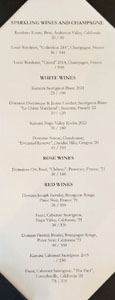
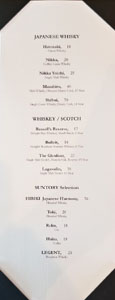
Uka focuses squarely on omakase kaiseki. The standard prix-fixe menu (which we had) is $300 a head, but there's an abbreviated offering at $200, and an enhanced shabu-shabu option at $400. Drink-wise, a beverage pairing is $120, and you'll find a reasonable selection of sakes and wines, along with a small array of spirits. Corkage is $75 per bottle, with a limit of two. Click for larger versions.
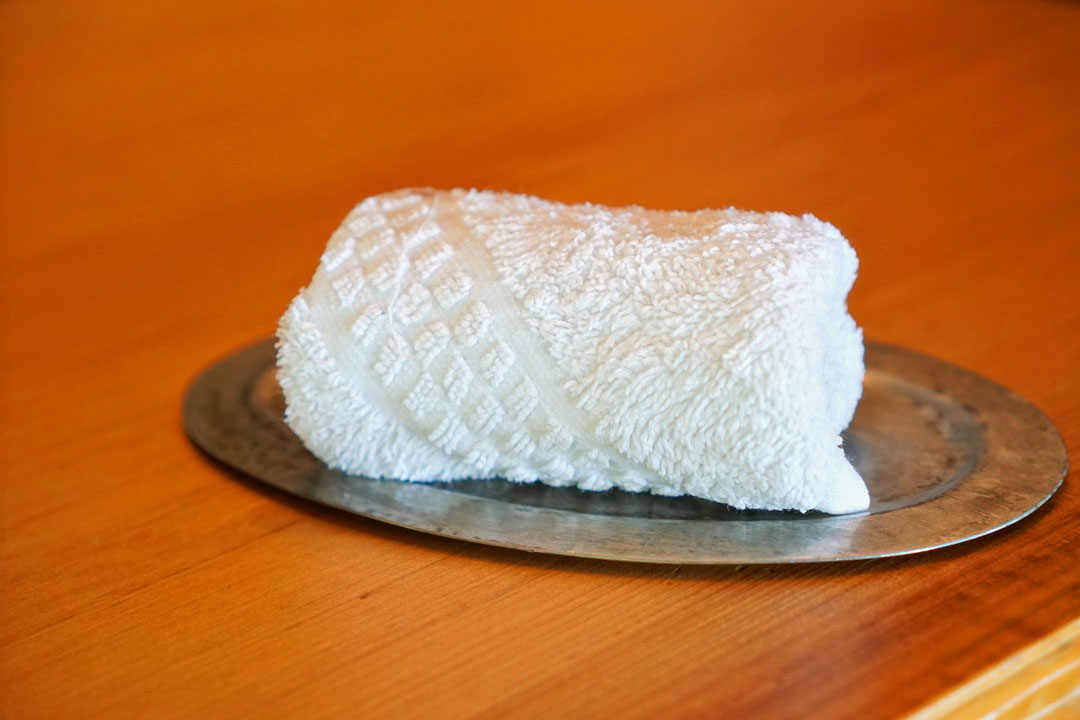
Upon being seated, we were quickly presented with oshibori, appropriately chilled for the hot summer weather we'd been experiencing.
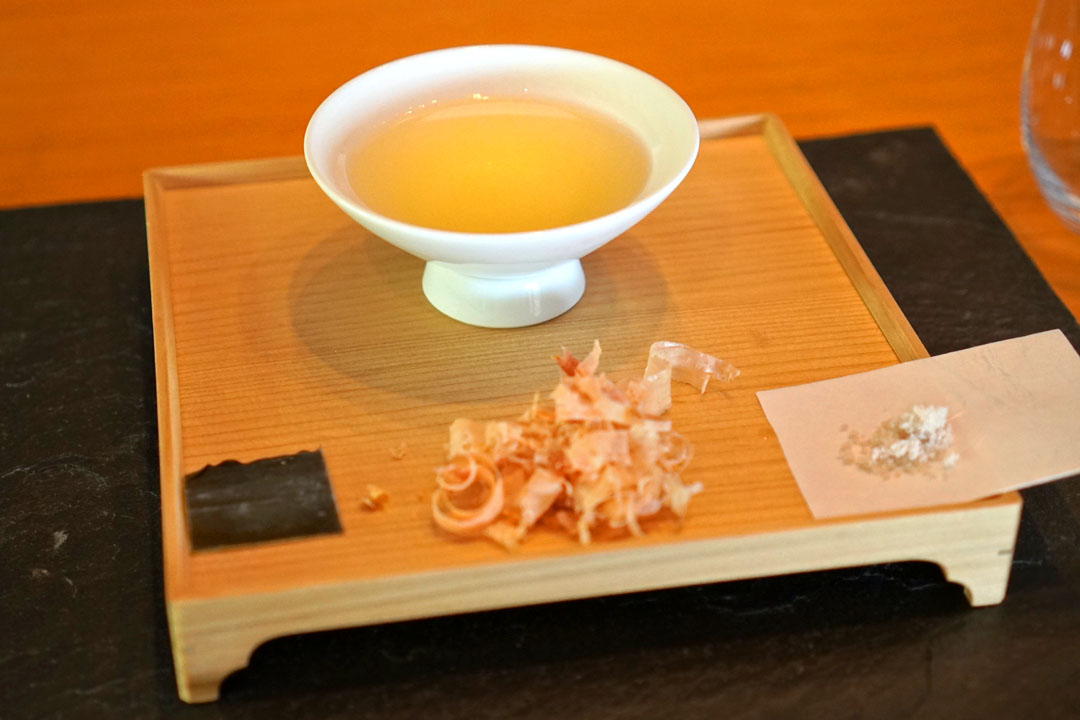
1: 五感の出汁 Dashi for the Five Senses | Traditional Broth of Kombu Kelp and Smoked Bonito Flakes
Our first course was the gokan no dashi, an oceany, umami-laden broth that was surprisingly light, with a very brief finish. The salt was key in bolstering the flavors at play, while the bonito flakes imparted further smoke, and the kelp both sweetness and complexity.

Here we see a specimen of katsuobushi, which, if you've never held it before, has a hard, almost wooden feel.
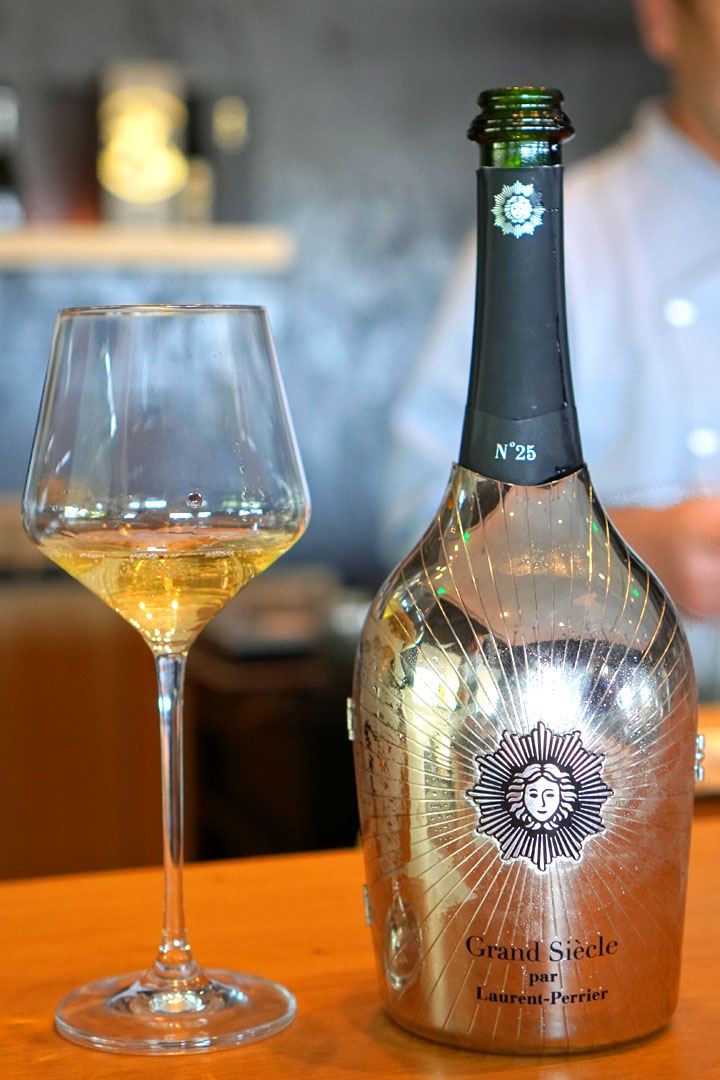
To drink, we brought along a bottle of the Laurent-Perrier Champagne Grand Siècle № 25, a multi-vintage bottling comprised of juice from 2006 (10%), 2007 (25%), and 2008 (65%). Aromas here were all about concentrated notes of luscious apples, honey, and brioche. On the palate, I found a welcoming acidity, with flavors of orchard fruit, citrus, and more honey, as well as a distinct minerality. And as the wine warmed up, I got even more honey, even more brioche. This was drinking deliciously tonight, but will likely get even better with age.
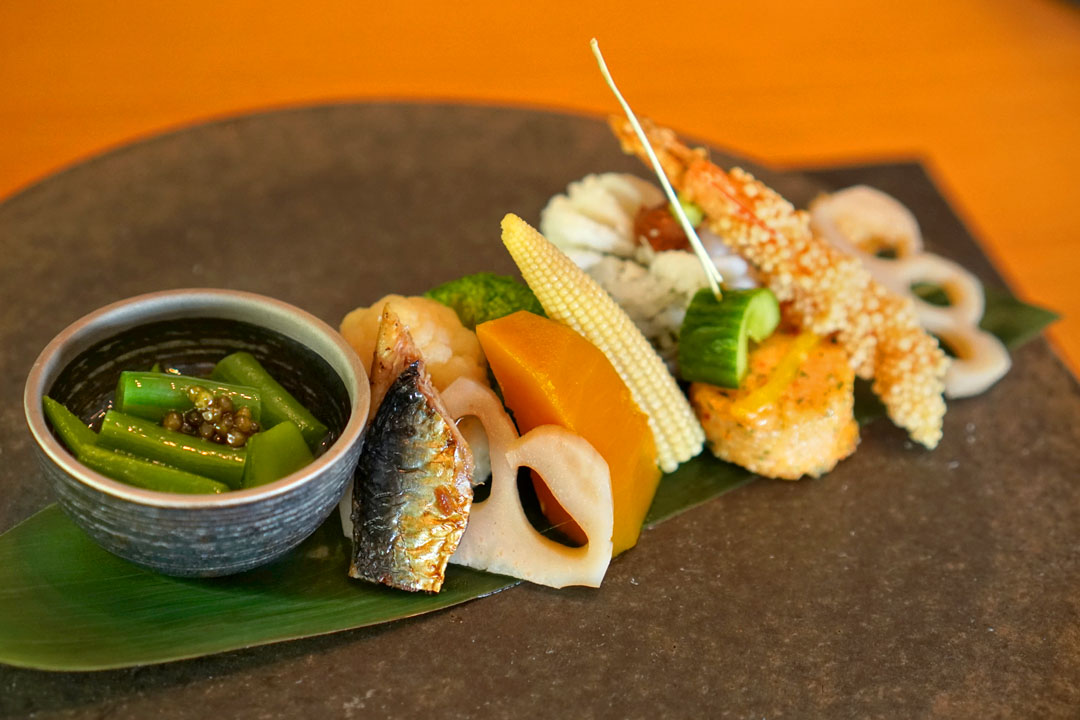
2: 八寸 Seasonal Appetizer | Chef's Daily Creation of Bite-Sized Starters Featuring Seafood, Seasonal Beans and Fried Arare Shrimp
Our hassun course was composed of six selections. Eating from left to right: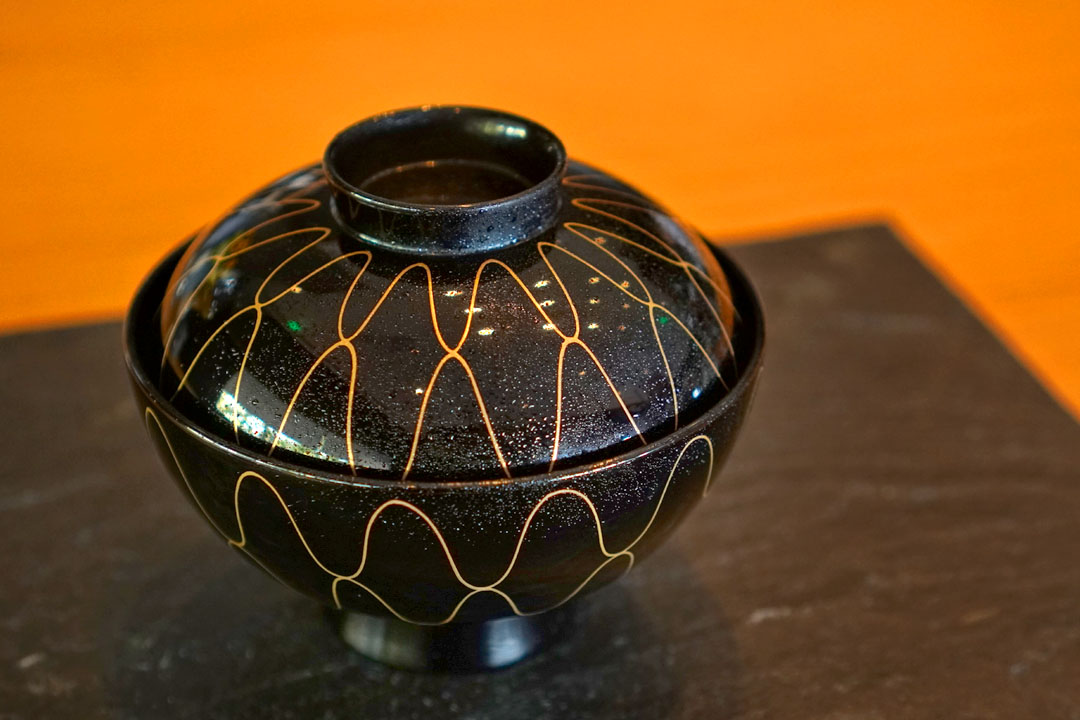
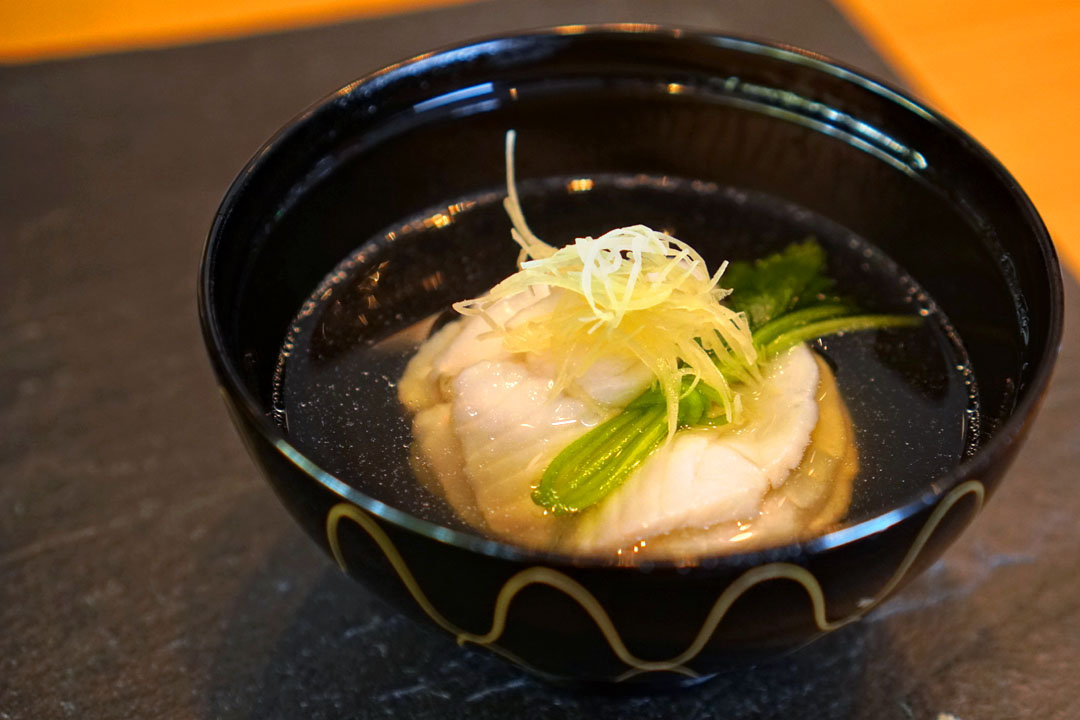
3: お椀 Ainame in Dashi | Grilled Eggplant, Ginger, Mitsuba
Next up was the owan, which featured fat greenling, a fish rarely seen around these parts. The ainame possessed a particularly elegant taste and mouthfeel, which was enhanced by its "flower" cut. At the same time, the smokiness of the eggplant amped things up, and I appreciated that light-yet-heady broth. Note the water sprayed on the bowl, which ostensibly symbolizes the virtue of the dish and that it came directly from the Chef to us.
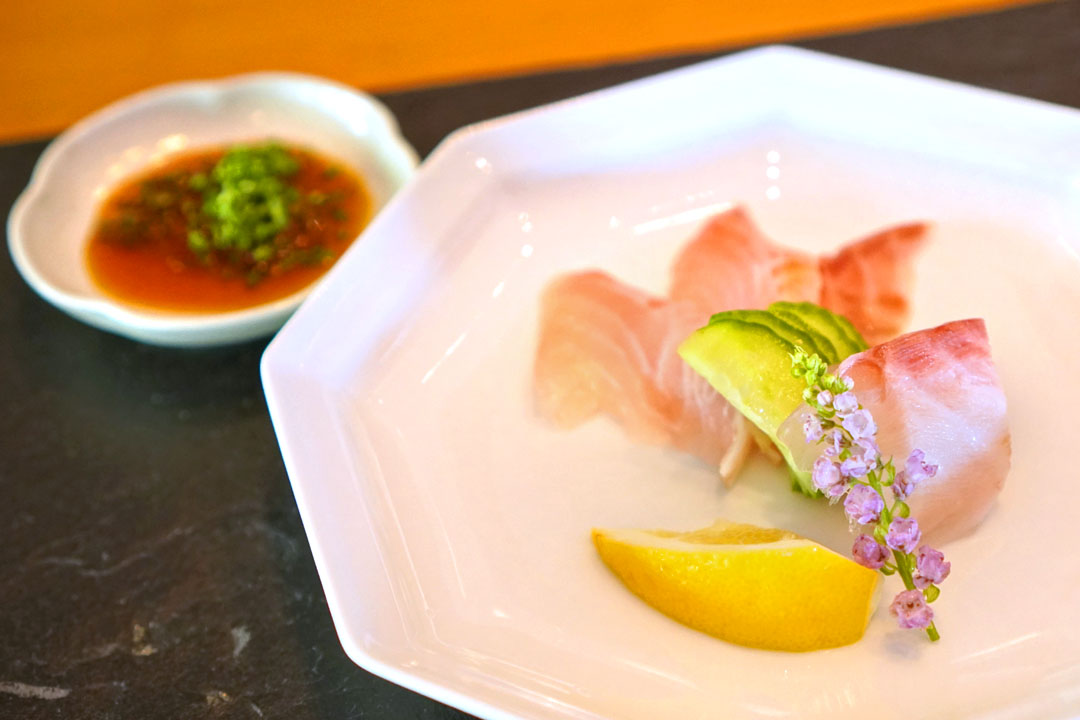
4a: お造り Chef's Choice Sashimi | Isaki with Chirizu Sauce
The first part of our otsukuri course showcased 10-day-aged Japanese chicken grunt, a superbly-textured fish with a clean, concentrated flavor profile. It meshed swimmingly with that piquant chiri-zu on the side, in which we were instructed to break off the shiso flowers.
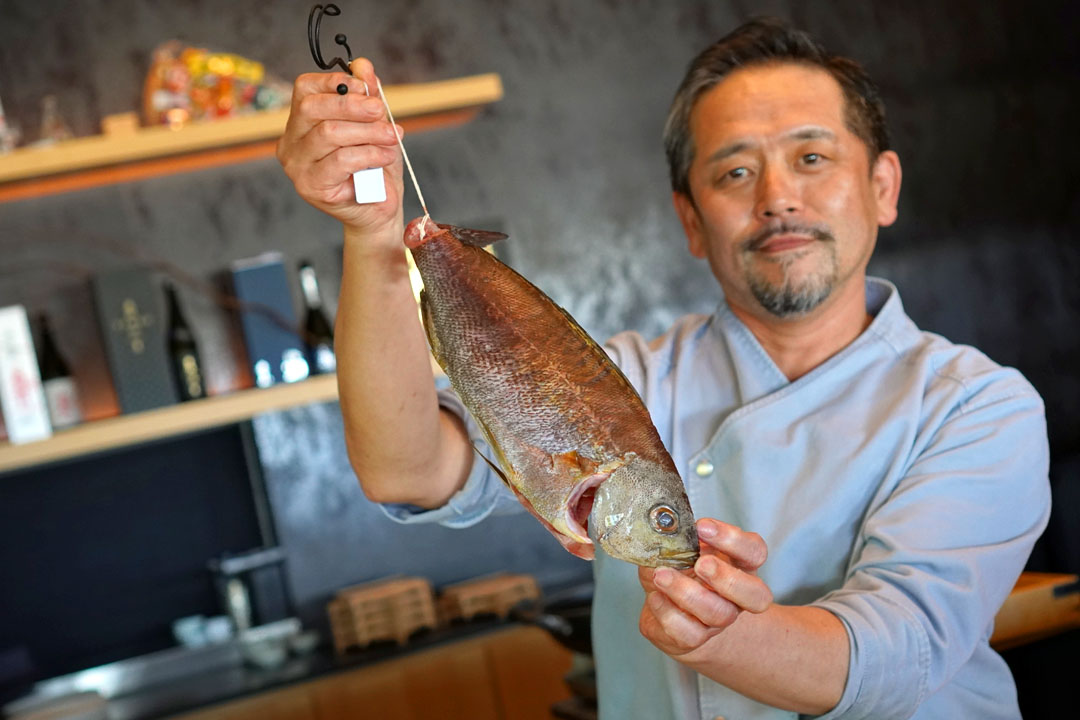
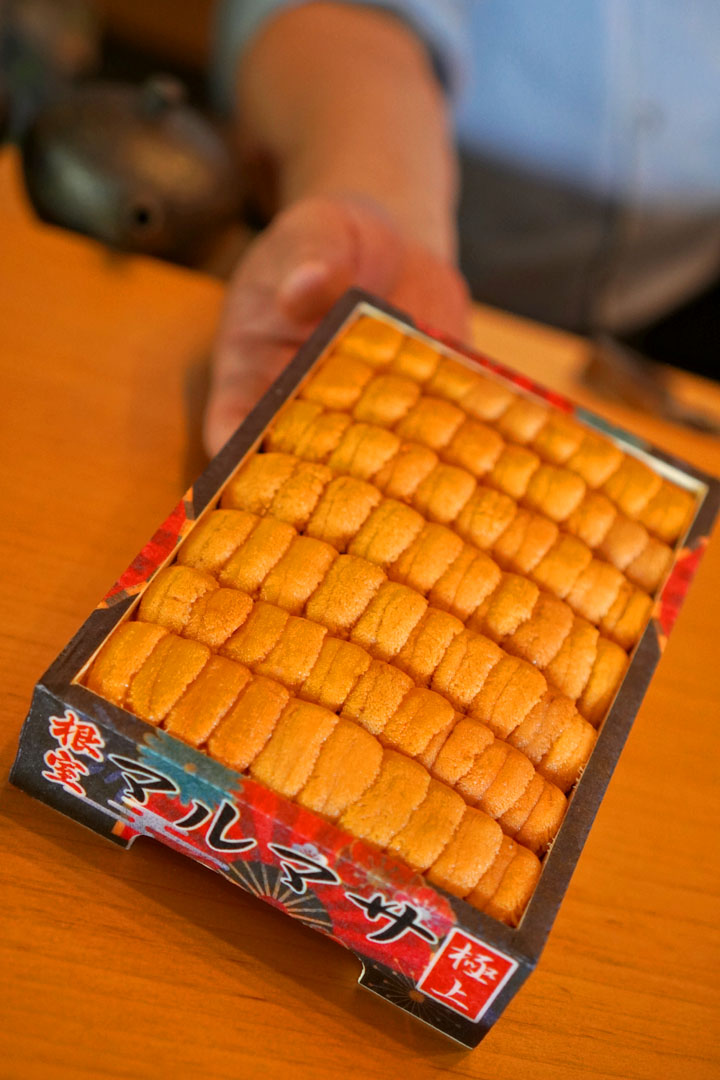
Here we see Mitsue-san showing off the aged threeline grunt from above, along with a tray of bafun uni.

4b: お造り Chef's Choice Sashimi | Tuna, Sawara and Uni with Soy Sauce and Fresh Wasabi
Next came the requisite sashimi moriawase, which highlighted the following: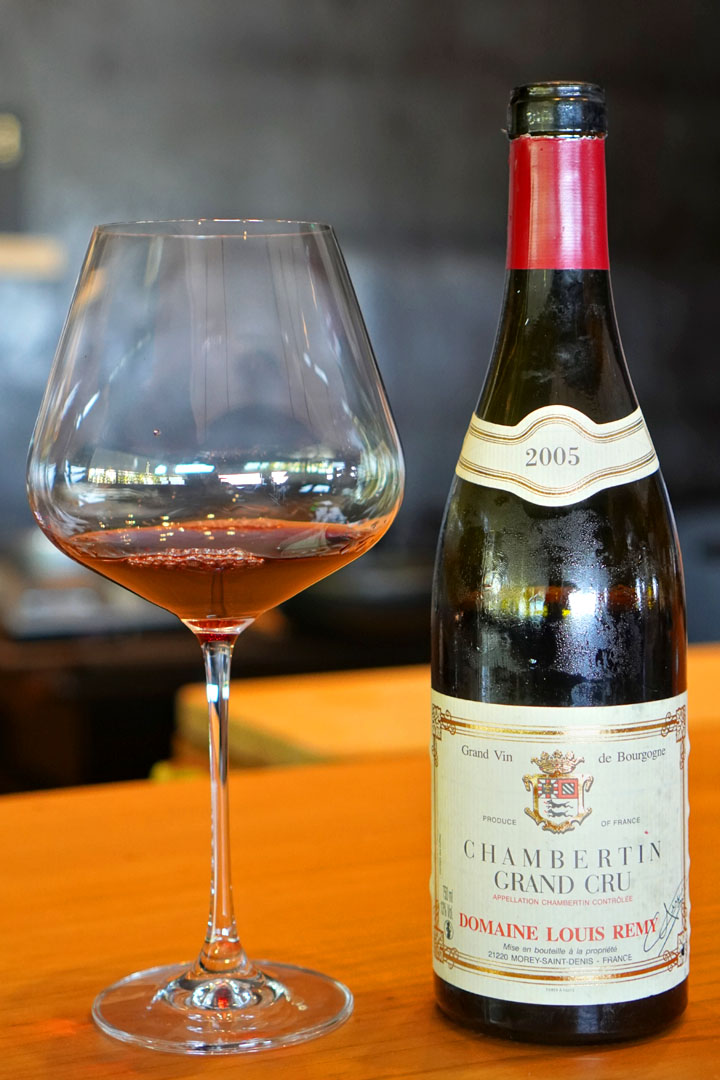
Our second BYOB selection was the 2005 Domaine Louis Remy Chambertin Grand Cru. The Burgundy demonstrated some wonderful aromatics, its bouquet featuring a dance of violets, iron, and black pepper. On the palate, the wine was nearly silken, with inviting red fruits commingled with bountiful earth and funk. With time, I began getting a more herbaceous presentation on the nose, along with a bit more smoke. Overall, a strong showing from a famously strong vintage.

5: 煮物 Tilefish with Black Truffle | Cabbage Puree, King Crab and Japanese Traditional Ginan Sauce
Nimono duties were handled by a dense, savory, truffle-boosted serving of steamed amadai, evened out by bitter Brussels sprouts and cabbage purée, with the sweetness of that tarabagani tying the dish together. I found an unexpected but not unwelcomed use of nontraditional ingredients here, making this my favorite dish of the evening.
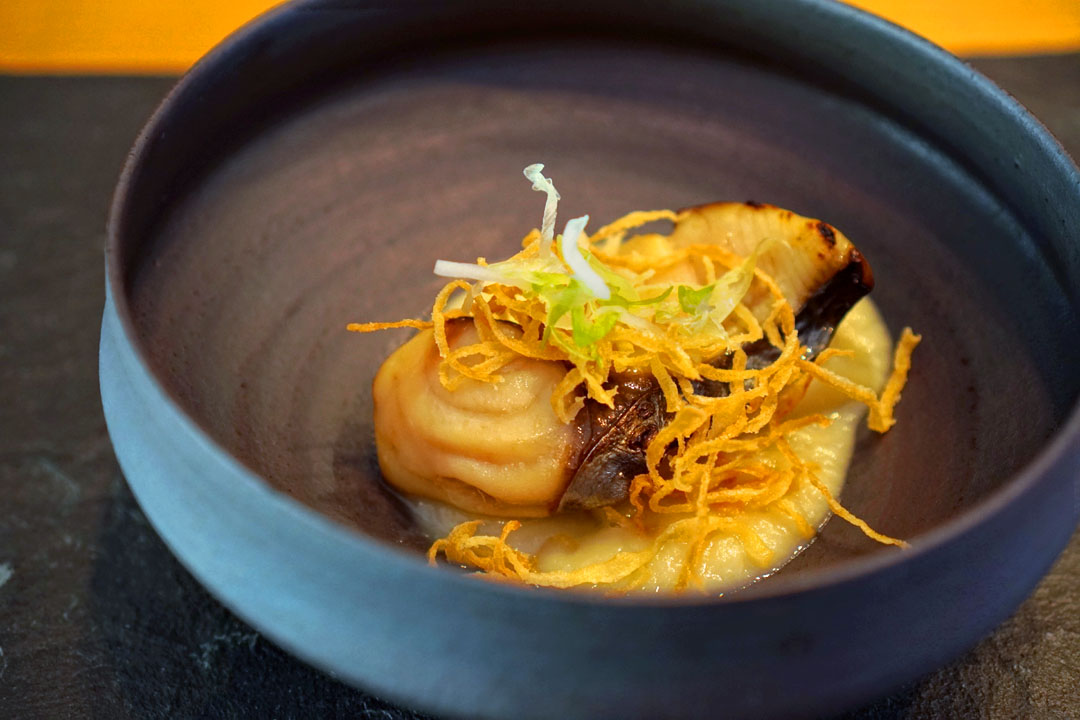
6: 焼き物 魚 Marinated Sawara in Miso | French-inspired Onion Miso Sauce
A sweet-n-savory, nearly-decadent serving of king mackerel served as our yakimono sakana course. The fish was well-tempered by that creamy onion sauce and those crispy bits of fried onion, while scallions functioned as a zesty accent piece.

An off-menu shinogi course was provided at this point. What we had was a wonderfully sweet and saline shrimp toast, replete with crispy bread and a side of pickles. Fun and tasty.
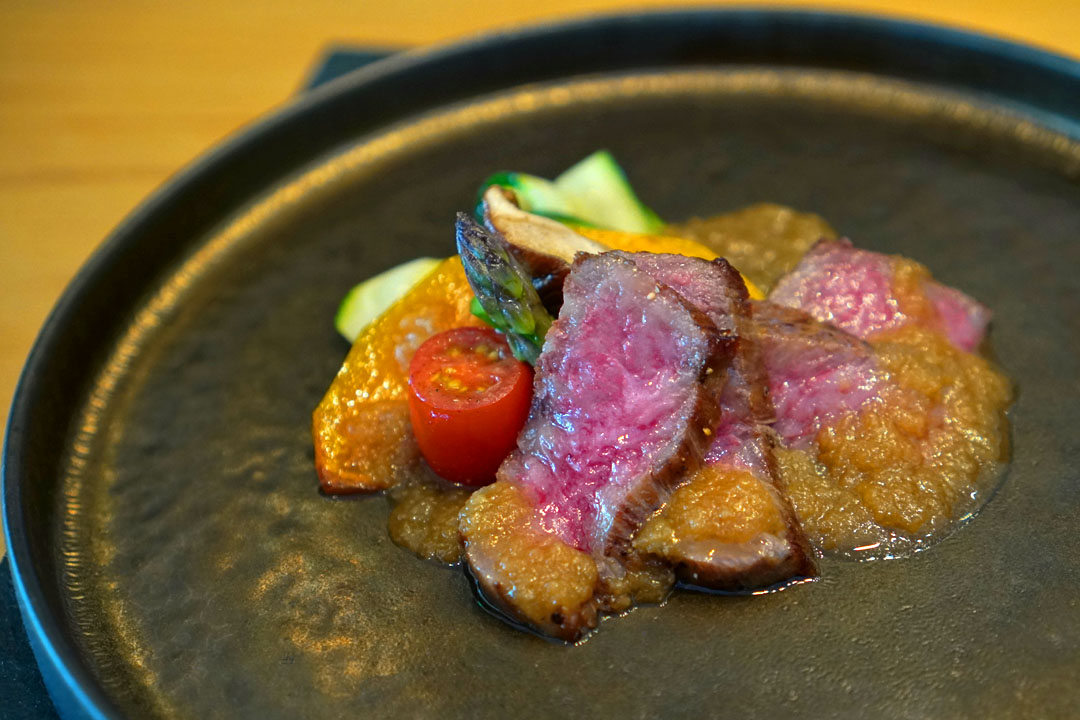
7: 焼き物 肉 Wagyu Miyazaki Beef Sirloin Steak | Seasonal Vegetables, Oroshi Ponzu Sauce
Yakimono niku responsibilities were the task of this fatty cut of Miyazaki wagyu. I would've liked a stronger sear and smoke on the meat, but the beef still linked up handily with that zingy radish sauce, and I appreciated the contrast offered up by those veggies, too.
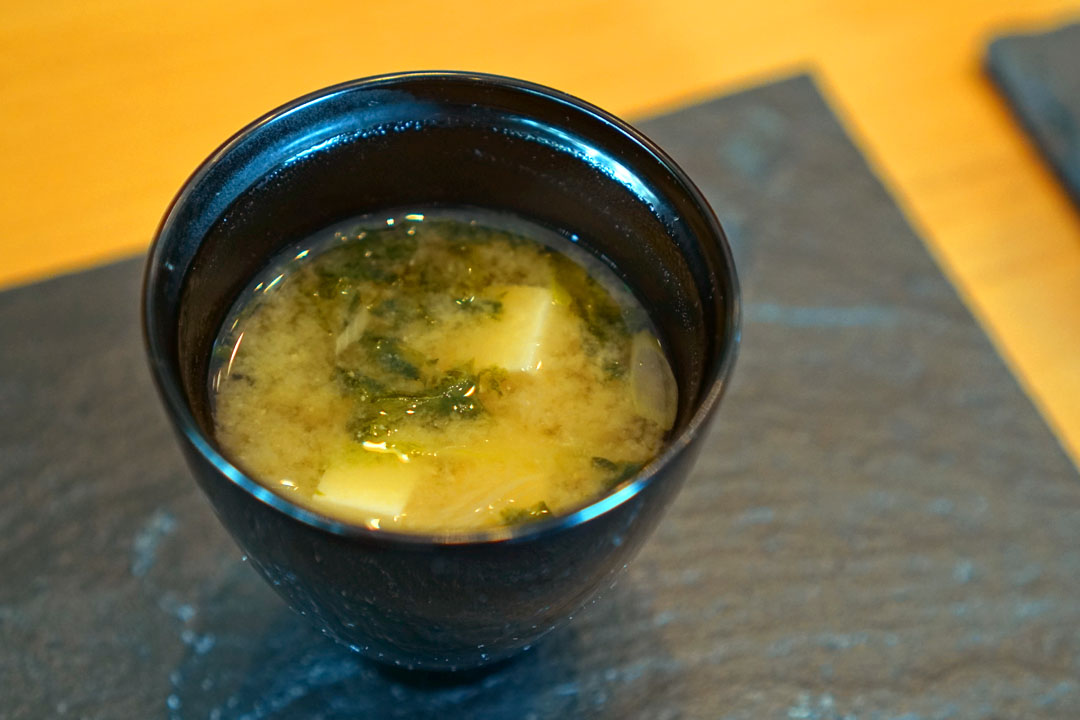
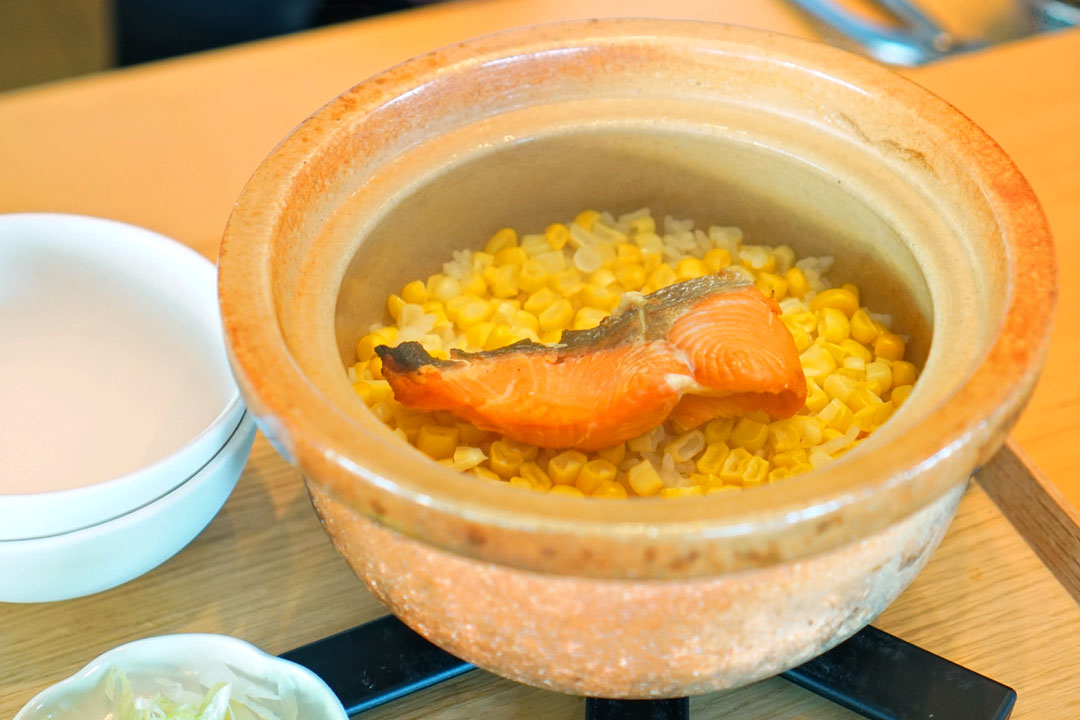
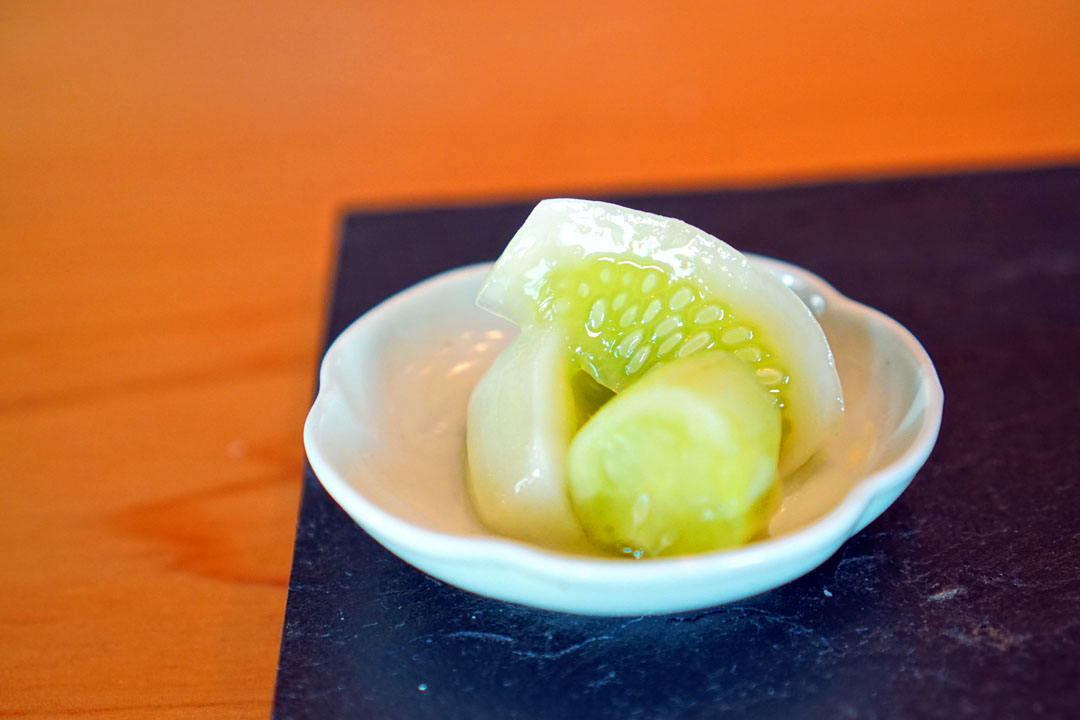
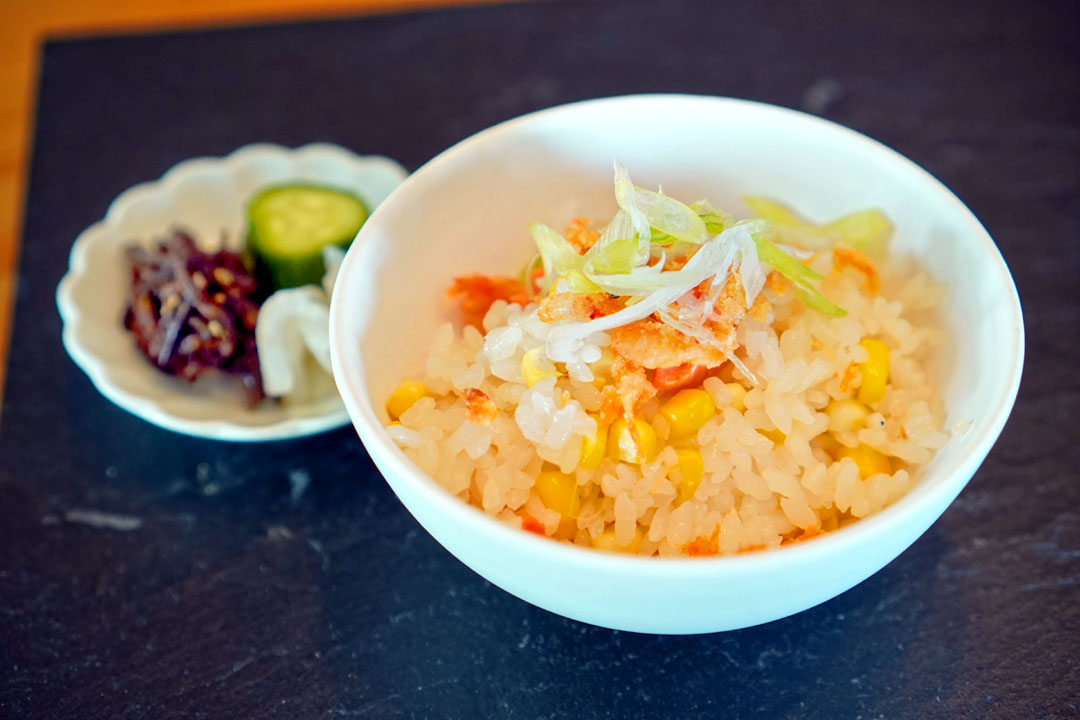
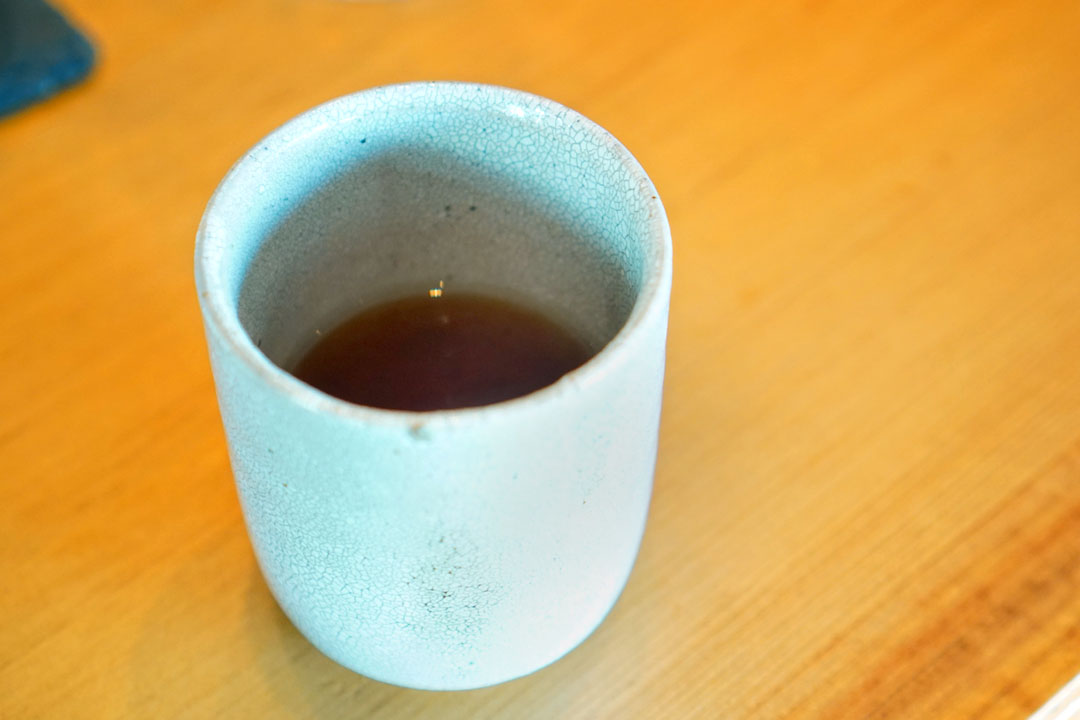
8: お食事 Traditional Koshihikari Rice Course | Delicately seasoned rice prepared in earthenware pot, with miso soup and Tsukemono (Japanese pickles) and Kyoto-grown organic Hojicha tea
Not surprisingly, the oshokuji course was the most substantial of the night. Prepared in a donabe, the rice was perfectly textured, and served as a very fitting stage for the scrumptiously saline marriage of salmon and shrimp, with sweet corn and green onion lightening the mood. The tangy crunch of those pickles was much appreciated too, as was that hot, roasty cup of tea.
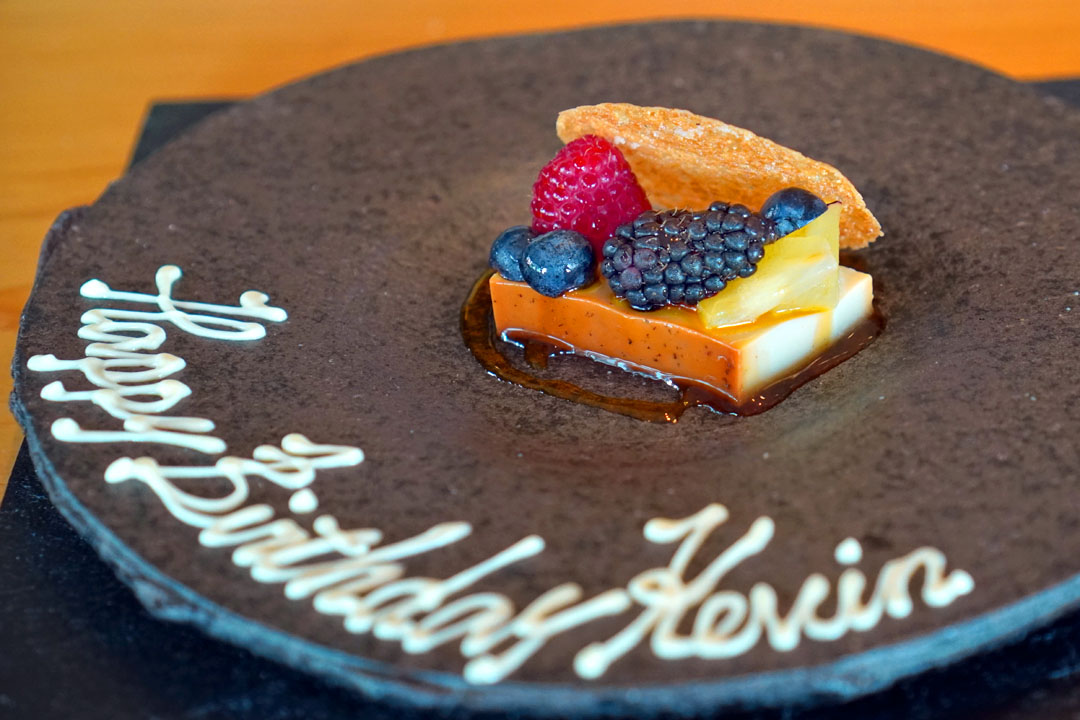
9: 甘味 Seasonal Dessert | Hojicha Pudding with Fruits
Last up was the kanmi: a sweet, toasty, nutty pudding accompanied by tart-n-tangy fruit. I have to assume that it was a creation of Kato-san, who does have a proclivity for desserts.
I was bummed that Inn Ann closed, so it's nice to see the restaurant space back in use, especially since I'd thought that it might never reopen. It's evident that both Mitsue and Kato put thought and care into the cooking, which highlights the traditional tropes of kaiseki while incorporating the occasional bit of international influence. It all adds up to a fitting introduction to kaiseki cooking, but at the same time, I'd like to see the Chefs push things a bit more, to go gutsier, bolder. Uka was awarded a Michelin star at the start of August, so I'm curious to find out if that'll provide further inspiration to the team.
6801 Hollywood Blvd, Los Angeles, CA 90028
213-808-2021
www.japanhousela.com/restaurant/uka/
Sun 07/14/2024, 05:00p-07:40p

Back in 2019, I enjoyed a lovely meal at Inn Ann, a sushi spot located inside Japan House, a venue funded by the Japanese government that's meant to promote the country's culture. However, Inn Ann closed at the start of 2020, with the idea that the restaurant would be transformed into a "culinary incubator" of sorts. The pandemic delayed those plans, and the place only re-opened in February 2022 with a dinner series entitled "A5 Wagyu Experience," which ran through that April. It was followed by "Ramen Discoveries" (May to July 2022), "Defining Modern Kaiseki" with Hiroo Nagahara (November to December 2022), and finally, "SAIDO's Vegan Way" with Katsumi Kusumoto (January 2023). Not long after, it was announced that the space would become Uka (宇迦), a kaiseki-focused concept named after Ukanomitama-no-kami (宇迦之御魂神), a deity associated with food. The newcomer grand-opened at the start of June last year, helmed by Yoshitaka Mitsue and Shingo Kato.
About the Chefs: Mitsue Yoshitaka (満江善隆) was born and raised in the city of Imari in Saga Prefecture. He attended Saga Prefectural Imari Agricultural and Forestry High School (佐賀県立伊万里農林高等学校), graduating in 1989, and at the age of 18, started his culinary apprenticeship in Osaka. During this period, he largely focused his attention on kappo-style cookery, and also worked at a fish market for two years. By 1999, he was abroad for the first time cooking at Restaurant Suntory in Paris, which was located on Rue Lincoln just off the Champs-Élysées, in the current home of Le Bar Ladurée. In April 2007, Mitsue opened his own eight-seater kappo spot in Kobe: 旬彩和食 朱zaku, or Junsai Washoku Suzaku.
This was followed up in 2011 by See Daeng (スィーデーン), a Thai eatery located nearby. However, he shuttered Suzaku in September 2014, and the following month, moved with his wife Aya to New York to become Chef for the Permanent Mission of Japan to the United Nations. He stayed in that position until November 2019, after which he returned to Japan for a bit, then relocated to Strasbourg, France in 2020. There, he headed up the kitchen at the official residence of the Consul General of Japan before returning back to the US and joining the team at Japan House.
Sous Chef Kato Shingo (加藤眞吾) was born in Zushi, Kanagawa in 1988. He attended culinary school at the Tokyo Seishin Technical College for Cooking (東京誠心調理師専門学校), where he largely trained in Western cookery. Following his studies, he taught for six months, then landed a position at Tokyo's iconic Imperial Hotel, where he specialized in French cuisine. In 2013, Kato came to the US to cook at the Permanent Mission of Japan to the United Nations, where he again focused on French, though he also developed more of an appreciation for Japanese cooking during his tenure there. Following, he returned to the Imperial Hotel in 2016, but in 2019, left for Riga, Latvia to cook at the Embassy of Japan. Two years later, the Chef was back at the Imperial Hotel's casual Parkside Diner, where he stayed until coming to LA, officially starting work at Uka in May 2023.


We arrived early for our reservation, and thus waited for a bit in the library, where we enjoyed some complimentary iced green tea.

Inside the Ryu Kosaka-designed restaurant, things haven't changed much at all from the Inn Ann days. Shown above is my view from the leftmost section of the dining counter.





Uka focuses squarely on omakase kaiseki. The standard prix-fixe menu (which we had) is $300 a head, but there's an abbreviated offering at $200, and an enhanced shabu-shabu option at $400. Drink-wise, a beverage pairing is $120, and you'll find a reasonable selection of sakes and wines, along with a small array of spirits. Corkage is $75 per bottle, with a limit of two. Click for larger versions.

Upon being seated, we were quickly presented with oshibori, appropriately chilled for the hot summer weather we'd been experiencing.

1: 五感の出汁 Dashi for the Five Senses | Traditional Broth of Kombu Kelp and Smoked Bonito Flakes
Our first course was the gokan no dashi, an oceany, umami-laden broth that was surprisingly light, with a very brief finish. The salt was key in bolstering the flavors at play, while the bonito flakes imparted further smoke, and the kelp both sweetness and complexity.

Here we see a specimen of katsuobushi, which, if you've never held it before, has a hard, almost wooden feel.

To drink, we brought along a bottle of the Laurent-Perrier Champagne Grand Siècle № 25, a multi-vintage bottling comprised of juice from 2006 (10%), 2007 (25%), and 2008 (65%). Aromas here were all about concentrated notes of luscious apples, honey, and brioche. On the palate, I found a welcoming acidity, with flavors of orchard fruit, citrus, and more honey, as well as a distinct minerality. And as the wine warmed up, I got even more honey, even more brioche. This was drinking deliciously tonight, but will likely get even better with age.

2: 八寸 Seasonal Appetizer | Chef's Daily Creation of Bite-Sized Starters Featuring Seafood, Seasonal Beans and Fried Arare Shrimp
Our hassun course was composed of six selections. Eating from left to right:
- Bright, crunchy peas and green beans were crowned with a salty dollop of caviar.
- Marinated sardine showed off a mouthwatering salinity and savor that juxtaposed well with the preceding veggies.
- Dashi-steamed vegetables presented an array of disparate tastes and textures.
- The ebi shinjo (shrimp dumpling) was my favorite of the sextet thanks to its soft, lingering brine that was offset just a smidge by cucumber.
- Hamo sushi featured a nearly "fluffy" cut of pike conger eel paired with a tangy, almost minty plum tapenade, with the rice serving as a moderating force.
- Lastly, we had a tasty fried shrimp coated with crunchy rice crackers. I wouldn't have minded a few more of these guys.


3: お椀 Ainame in Dashi | Grilled Eggplant, Ginger, Mitsuba
Next up was the owan, which featured fat greenling, a fish rarely seen around these parts. The ainame possessed a particularly elegant taste and mouthfeel, which was enhanced by its "flower" cut. At the same time, the smokiness of the eggplant amped things up, and I appreciated that light-yet-heady broth. Note the water sprayed on the bowl, which ostensibly symbolizes the virtue of the dish and that it came directly from the Chef to us.

4a: お造り Chef's Choice Sashimi | Isaki with Chirizu Sauce
The first part of our otsukuri course showcased 10-day-aged Japanese chicken grunt, a superbly-textured fish with a clean, concentrated flavor profile. It meshed swimmingly with that piquant chiri-zu on the side, in which we were instructed to break off the shiso flowers.


Here we see Mitsue-san showing off the aged threeline grunt from above, along with a tray of bafun uni.

4b: お造り Chef's Choice Sashimi | Tuna, Sawara and Uni with Soy Sauce and Fresh Wasabi
Next came the requisite sashimi moriawase, which highlighted the following:
- The sea urchin was on point, and worked well with both the freshly-grated wasabi and that cucumber "butterfly."
- I then tried the 12-day-aged bluefin toro, sourced from Mexico. It ate as fatty and lush and dense as I was expecting, so the countering sting of wasabi was crucial.
- Last up was the three-day-aged Spanish mackerel, which had a lovely smoke, and seemed to draw out the fruitiness of the wine below.

Our second BYOB selection was the 2005 Domaine Louis Remy Chambertin Grand Cru. The Burgundy demonstrated some wonderful aromatics, its bouquet featuring a dance of violets, iron, and black pepper. On the palate, the wine was nearly silken, with inviting red fruits commingled with bountiful earth and funk. With time, I began getting a more herbaceous presentation on the nose, along with a bit more smoke. Overall, a strong showing from a famously strong vintage.

5: 煮物 Tilefish with Black Truffle | Cabbage Puree, King Crab and Japanese Traditional Ginan Sauce
Nimono duties were handled by a dense, savory, truffle-boosted serving of steamed amadai, evened out by bitter Brussels sprouts and cabbage purée, with the sweetness of that tarabagani tying the dish together. I found an unexpected but not unwelcomed use of nontraditional ingredients here, making this my favorite dish of the evening.

6: 焼き物 魚 Marinated Sawara in Miso | French-inspired Onion Miso Sauce
A sweet-n-savory, nearly-decadent serving of king mackerel served as our yakimono sakana course. The fish was well-tempered by that creamy onion sauce and those crispy bits of fried onion, while scallions functioned as a zesty accent piece.

An off-menu shinogi course was provided at this point. What we had was a wonderfully sweet and saline shrimp toast, replete with crispy bread and a side of pickles. Fun and tasty.

7: 焼き物 肉 Wagyu Miyazaki Beef Sirloin Steak | Seasonal Vegetables, Oroshi Ponzu Sauce
Yakimono niku responsibilities were the task of this fatty cut of Miyazaki wagyu. I would've liked a stronger sear and smoke on the meat, but the beef still linked up handily with that zingy radish sauce, and I appreciated the contrast offered up by those veggies, too.





8: お食事 Traditional Koshihikari Rice Course | Delicately seasoned rice prepared in earthenware pot, with miso soup and Tsukemono (Japanese pickles) and Kyoto-grown organic Hojicha tea
Not surprisingly, the oshokuji course was the most substantial of the night. Prepared in a donabe, the rice was perfectly textured, and served as a very fitting stage for the scrumptiously saline marriage of salmon and shrimp, with sweet corn and green onion lightening the mood. The tangy crunch of those pickles was much appreciated too, as was that hot, roasty cup of tea.

9: 甘味 Seasonal Dessert | Hojicha Pudding with Fruits
Last up was the kanmi: a sweet, toasty, nutty pudding accompanied by tart-n-tangy fruit. I have to assume that it was a creation of Kato-san, who does have a proclivity for desserts.
I was bummed that Inn Ann closed, so it's nice to see the restaurant space back in use, especially since I'd thought that it might never reopen. It's evident that both Mitsue and Kato put thought and care into the cooking, which highlights the traditional tropes of kaiseki while incorporating the occasional bit of international influence. It all adds up to a fitting introduction to kaiseki cooking, but at the same time, I'd like to see the Chefs push things a bit more, to go gutsier, bolder. Uka was awarded a Michelin star at the start of August, so I'm curious to find out if that'll provide further inspiration to the team.
6 Comments:
Happy birthday, Kevin! I hope you get to try some of San Diego's now-numerous Omakase tables. Although most are less than LA prices, it'd still be great to get your opinion before I splurge at some of them.
Thanks! But are there any San Diego omakase spots that are actually worth the four-hour drive down and up? In other words, is there anything I can't get in LA?
The honest answer is probably not. I've done Soichi, Hidden Fish, Kokoro, the new Kinme, and Harmony 2B1. The latter two are more ambitious (by my standards, not yours), but I go to Hidden Fish the most despite its more staid menu. They get superb fish in a fun environment for $135. I think we'll start catching up to LA prices soon enough!
Probably not, but if you go to San Diego for any other reason a few I like are Harmony2B1, Kokoro, and the new Kinme in Banker's Hill. Hidden Fish is my go-to--omakase fans might find it unambitious but they serve all of my favorites for $135. Several new ones are open (or open soon).
Ah thanks for the recommendations. I'll have to keep them in mind if I ever find myself down in the San Diego area. Now speaking more broadly, are there SD restaurants of any type that really call for a special drive down? I've already tried the likes of Addison, Jeune et Jolie, and Valle.
Nope! You've already gotten the Big 3 Michelins. Best to wait until you have a reason to be here, and try some well-regarded mid-priced ones, like Callie downtown or Artifact in Balboa Park (both great), Fort Oak in Mission Hills (terrific Oyster Mondays), or the Japanese pancakes at Morning Glory (all the CH restaurants I've tried, about half of them, are inventive and tasty, moreso than the rival Cohn restaurants here https://consortiumholdings.com/projects/), Sometimes I just get a couple slices of Whitestone at Hillcrest's Bronx Pizza or brave the line at Barrio Logan's famous Las Cuatro Milpas.
Post a Comment
Subscribe to Post Comments [Atom]
<< Home